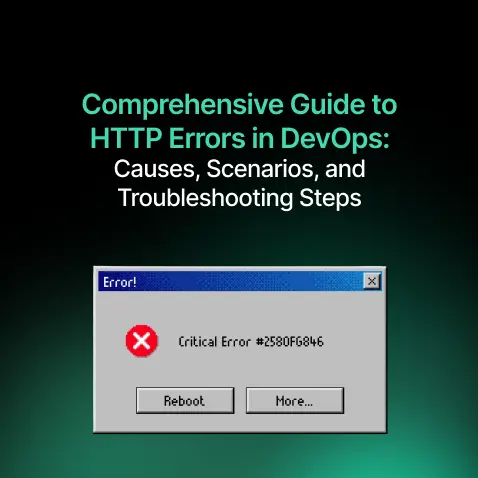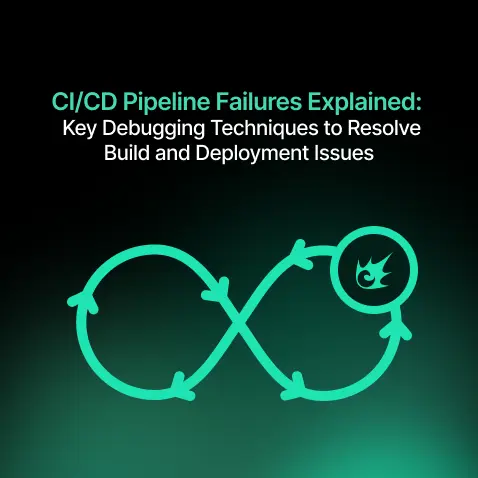What is SRE? A Beginner’s Guide to Site Reliability Engineering
- Nitin Yadav
- Knowledge
About

Site Reliability Engineering (SRE) blends software engineering with IT operations to build scalable, reliable systems. Learn the key principles of SRE like SLIs, SLOs, error budgets, and automation and how companies use it to reduce downtime, boost performance, and scale with confidence. Discover how SquareOps helps businesses implement full-stack SRE solutions for high availability and resilient infrastructure.
Industries
- AWS, AWS Azure, AWS Cloud Security, DevOps, Site Reliability Engineer, SRE, SRE Services in Gurgaon, SRE tools
Share Via
Always-on digital world, uptime isn’t a luxury—it’s a necessity. As software systems become increasingly complex and distributed, businesses face unprecedented pressure to maintain availability, reliability, and scalability. Enter Site Reliability Engineering (SRE)—a discipline that fuses software engineering with IT operations to create highly reliable and scalable systems.
If you’re new to SRE or looking to adopt it for your engineering organization, this guide will help you understand what SRE is, how it works, and why it’s becoming essential for modern tech teams.
What is SRE (Site Reliability Engineering)?
Site Reliability Engineering (SRE) is a set of principles and practices that apply software engineering methodologies to IT operations. The goal is to improve the reliability, scalability, and performance of software systems through automation, monitoring, and engineering excellence.
Coined at Google in the early 2000s, SRE was introduced as a formal role to bridge the gap between development and operations. Rather than relying on manual processes, SREs build software systems to solve operational problems—ensuring infrastructure and applications remain robust under pressure.
The History and Evolution of SRE
SRE began at Google under the leadership of Ben Treynor Sloss. The core idea? Let software engineers take responsibility for running production systems, armed with engineering best practices.
Since then, the approach has been widely adopted by companies like Netflix, LinkedIn, Dropbox, and Twitter, and has even led to dedicated roles such as SRE Engineers, Reliability Engineers, and Platform Engineers.
The popularity of SRE reflects a broader shift in engineering culture—moving away from traditional IT ops and toward infrastructure as code, automation-first thinking, and collaborative ownership of uptime.
Core Principles of SRE
SRE isn’t just a job title—it’s a philosophy. Here are the foundational principles:
1. SLIs, SLOs, and SLAs
- Service Level Indicators (SLIs) are metrics that quantify service behavior (e.g., latency, error rate).
- Service Level Objectives (SLOs) are targets for SLIs (e.g., 99.9% uptime).
- Service Level Agreements (SLAs) are contractual commitments.
Together, they ensure reliability is defined, measured, and managed effectively.
2. Error Budgets
SREs embrace the idea that 100% uptime is unrealistic. Error budgets define an acceptable margin of failure—allowing for innovation without compromising user experience.
3. Elimination of Toil
Toil refers to repetitive, manual, and automatable work. SREs aim to eliminate toil through automation and efficient tooling.
4. Monitoring and Observability
Good observability is crucial. SREs deploy tools to monitor logs, metrics, and traces—ensuring real-time visibility into system performance.
5. Blameless Postmortems
When incidents occur, SREs conduct detailed postmortems focused on learning—not blame. This helps improve systems and processes over time.
6. Automation at the Core
SREs automate everything from deployments to incident response. Automation reduces human error and increases system predictability.
SRE vs DevOps: What’s the Difference?
SRE and DevOps share similar goals—breaking silos and improving delivery speed—but they differ in execution:
|
Aspect |
DevOps |
SRE |
|
Philosophy |
Culture of collaboration |
Engineering discipline |
|
Origin |
IT operations + Agile |
Software engineering |
|
Key Focus |
Continuous delivery & feedback |
Reliability, uptime, scalability |
|
Measurement |
Lead time, deployment freq. |
SLIs, SLOs, error budgets |
|
Approach |
Practices + tools |
Metrics + automation |
In essence, SRE can be viewed as a way to implement DevOps with rigor and precision.
What Does an SRE Actually Do?
Site Reliability Engineers perform a wide array of tasks across the software lifecycle:
- Infrastructure Engineering: Build and maintain scalable cloud environments.
- Monitoring & Alerting: Implement tools like Prometheus, Grafana, or Datadog.
- CI/CD Pipelines: Set up and optimize continuous integration and deployment.
- Incident Management: Lead real-time incident response and postmortems.
- Capacity Planning: Forecast infrastructure needs based on usage trends.
- Chaos Engineering: Run failure tests to improve system resilience.
They also work closely with software developers, product teams, and security engineers to ensure that reliability is a shared responsibility.
Common SRE Tools and Technologies
Here’s a snapshot of popular tools that power modern SRE teams:
Monitoring & Observability:
- Prometheus
- Grafana
- Datadog
- New Relic
- Elastic Stack (ELK)
Incident Response:
- PagerDuty
- Opsgenie
- VictorOps
CI/CD & Automation:
- Jenkins
- ArgoCD
- GitHub Actions
- CircleCI
- Atmosly
Infrastructure as Code:
- Terraform
- Ansible
- Pulumi
These tools help eliminate toil, increase visibility, and streamline operations.
Benefits of Adopting SRE in Your Organization
Implementing SRE practices can dramatically improve operational outcomes:
- Enhanced Reliability: Reduced downtime and faster recovery
- Faster Deployments: With less fear of failure
- Continuous Improvement: Through learning-focused postmortems
- Data-Driven Decisions: With SLIs and SLOs at the core
- Stronger Collaboration: Dev + Ops working in unison
These benefits make SRE an essential framework for engineering-driven organizations.
When Should a Company Implement SRE?
Consider SRE if you’re facing:
- Frequent outages or performance degradation
- Growing user base or scale challenges
- Lack of observability or monitoring
- Inefficient incident response
Startups aiming for growth, SaaS platforms, and teams managing distributed architectures are prime candidates for adopting SRE.
Real-World SRE Use Cases
1. E-Commerce Platform
A leading marketplace reduced mean time to recovery (MTTR) by 70% after implementing a centralized observability stack.
2. Fintech App
A startup handling sensitive transactions reduced deployment risks by introducing blue-green deployments and canary releases with SRE support.
3. Streaming Service
A video-on-demand platform used chaos engineering to proactively test infrastructure and prepare for spikes in traffic.
How SquareOps Can Help You Implement SRE
At SquareOps, we’ve helped over 100+ engineering teams implement SRE frameworks tailored to their scale, stack, and goals.
Our SRE implementation services include:
- ✅ SRE Maturity Audits
- ✅ Observability Stack Setup (Datadog, ELK, etc.)
- ✅ CI/CD Pipeline Optimization
- ✅ 24/7 Incident Response Automation
- ✅ SLO & Error Budget Workshops
- ✅ Cloud Infrastructure Scaling
We don’t just set up tools—we design systems for reliability.
Final Thoughts: Why SRE is the Future
SRE is not just a trend—it’s a mindset that future-proofs your systems. As tech stacks become more distributed and user expectations grow, businesses must invest in engineering-led operations to stay competitive.
Whether you’re starting from scratch or scaling up, SRE provides the playbook for building systems that don’t just work—but thrive under pressure.
Looking to integrate SRE in your organization? Book a free SRE consultation with SquareOps. Let’s make reliability your superpower.
Frequently asked questions
SRE stands for Site Reliability Engineering—a discipline that applies software engineering principles to operations.
SRE is a specific implementation of DevOps, focused heavily on metrics, automation, and reliability through engineering practices.
An SRE manages system reliability, builds monitoring tools, handles incident response, and automates operational tasks.
These are reliability metrics: SLIs (indicators), SLOs (objectives), and SLAs (agreements) that define and measure system performance.
Error budgets allow a defined threshold of failure, helping balance innovation and reliability.
Popular SRE tools include Prometheus, Grafana, Datadog, Terraform, Jenkins, and PagerDuty.
Companies experiencing scale, reliability issues, or rapid deployments should consider SRE for stability
No. SRE principles can be adapted by startups, SaaS platforms, and mid-sized businesses seeking reliability at scale.
By automating deployments, monitoring systems, responding to incidents, and conducting postmortems, SREs ensure higher uptime
Yes, SquareOps offers full-stack SRE implementation including tooling, SLO setup, CI/CD automation, and 24/7 monitoring.
Related Posts

Comprehensive Guide to HTTP Errors in DevOps: Causes, Scenarios, and Troubleshooting Steps
- Blog

Trivy: The Ultimate Open-Source Tool for Container Vulnerability Scanning and SBOM Generation
- Blog

Prometheus and Grafana Explained: Monitoring and Visualizing Kubernetes Metrics Like a Pro
- Blog

CI/CD Pipeline Failures Explained: Key Debugging Techniques to Resolve Build and Deployment Issues
- Blog

DevSecOps in Action: A Complete Guide to Secure CI/CD Workflows
- Blog

AWS WAF Explained: Protect Your APIs with Smart Rate Limiting
- Blog

